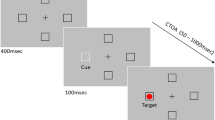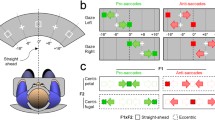Abstract
We previously showed that when attention is allocated to the right or left of the fixation point, saccades directed to targets located above or below the fixation point deviate contralateral to the attention locus. In the present study, we examined how general this phenomenon is and whether the amount of saccade deviation depends on the location of attention with respect to that of the saccade target. Three experiments were carried out. In experiment 1 the location of the imperative stimulus was uncued. Its presentation exogenously directed attention to its location. In experiment 2 the location of the imperative stimulus was cued by a central cognitive cue. In this experiment attention was endogenously directed to the imperative stimulus location before its presentation (expectancy paradigm). In experiment 3 all stimulus boxes contained a possible imperative stimulus at the display presentation. A central cue, presented subsequently, indicated which of them had to be used for the saccade. In this experiment attention was endogenously directed to the imperative stimulus, but after its presentation (no-expectancy paradigm). The results showed that, regardless of how attention was directed to the imperative stimulus, the vertical saccades deviated contralateral to the attention location. The deviation was larger when attention was in the upper field and the saccade was directed upward (“same hemifield” condition) than when attention was in the upper field and the saccade was directed downward (“opposite hemifield” condition). The same relationship between the “same hemifield” condition and “opposite hemifield” condition was found when attention was in the lower field. Saccadic reaction times (SRTs) were shortest in experiment 2 and longest in experiment 3. In experiment 2, SRTs of the “same hemifield” condition were significantly longer than those of the “opposite hemifield” condition. Taken altogether, these results strongly support the notion that attention allocation in space leads to an activation of oculomotor circuits, in spite of eye immobility. The possible mechanisms responsible for saccade deviations and for greater saccade deviations when attention is in the same hemifield as the programmed ocular saccade are discussed.
Similar content being viewed by others
References
Allport DA, Antonis B, Reynolds P (1972) On the division of attention: a disproof of the single channel hypothesis. Q J Exp Psychol 24: 225–235
Bach M, Bouis D, Fischer B (1983) An accurate and linear infrared oculometer. J Neurosci Methods 9: 9–14
Berlucchi G, Tassinari G, Marzi CA, Di Stefano M (1989) Spatial distribution of the inhibitory effect of peripheral non-informative cues on simple reaction-time to non-foveal visual targets. Neuropsychologia 27: 201–221
Downing CJ, Pinker S (1985) The spatial structure of visual attention. In: Posner MI, Marin OSM (eds) Attention and performance XI. Erlbaum, Hillsdale, NJ, pp 171–187
Duhamel J, Colby CL, Goldberg ME (1992) The updating of the representation of visual space in parietal cortex by intended eye movements. Science 255: 90–92
Egly R, Homa D (1991) Reallocation of visual attention. J Exp Psychol Hum Percept Perform 17: 142–159
Fitts PM, Deininger RL (1954) S-R compatibility: correspondence among paired elements within stimulus and response codes. J Exp Psychol 48: 483–492
Fitts PM, Seeger CM (1953) S-R compatibility: spatial characteristics of stimulus and response codes. J Exp Psychol 46: 199–210
Hellige JB (1990) Hemispheric asymmetry. Annu Rev Psychol 41: 55–80
Henderson JM, Macquistan AD (1993) The spatial distribution of attention following an exogenous cue. Percept Psychophys 53: 221–230
Hikosaka O, Wurtz RH (1983a) Visual and oculomotor functions of monkey substantia nigra pars reticulata. I. Relation of visual and auditory responses to saccades. J Neurophysiol 49: 1230–1253
Hikosaka O, Wurtz RH (1983b) Visual and oculomotor functions of monkey substantia nigra pars reticulata. IV. Relation of substantia nigra to superior colliculus. J Neurophysiol 49: 1285–1301
Hikosaka O, Sakamoto M, Usui S (1989a) Functional properties of monkey caudate neurons. I. Activities related to saccadic eye movements. J Neurophysiol 61: 780–798
Hikosaka O, Sakamoto M, Usui S (1989b) Functional properties of monkey caudate neurons. III. Activities related to expectation of target and reward. J Neurophysiol 61: 814–832
Hughes HC, Zimba LD (1985) Spatial maps of directed visual attention. J Exp Psychol Hum Percept Perform 11: 409–430
Hughes HC, Zimba LD (1987) Natural boundaries for the spatial spread of directed visual attention. Neuropsychologia 25: 5–18
Jonides J (1981) Voluntary versus automatic control over the mind's eye's movement. In: Long JB, Baddeley AD (eds) Attention and performance IX. Erlbaum, Hillsdale, NJ, pp 187–203
Kahneman D (1973) Attention and effort. Prentice-Hall, New York
Keele SW (1973) Attention and human performance. Goodyear, Pacific Palisades, Calif
Kinsbourne M, Hiscock M (1983) Asymmetries of dual task performance. In: Hellige J (ed) Cerebral hemisphere asymmetry: methods, theory and application. Academic Press, New York, pp 255–334
Klein RM (1980) Does oculomotor readiness mediate cognitive control of visual attention? In: Nickerson RS (ed) Attention and performance VIII. Erlbaum, Hillsdale, NJ, pp 259–276
Klein RM, Kingstone A, Pontefract A (1992) Orienting of visual attention. In: Rayner K (ed) Eye movements and visual cognition: scene perception and reading. Springer, New York Berlin Heidelberg, pp 46–65
Kornblum S (1965) Response competition and/or inhibition in two-choice reaction time. Psychon Sci 2: 55–56
LaBerge D, Brown V (1989) Theory of attentional operations in shape identification. Psychol Rev 96: 101–124
Lempert H, Kinsbourne M (1985) The effect of visual guidance and hemispace on lateralized vocal-manual interference. Neuropsychologia 23: 691–695
Maylor EA (1985) Facilitatory and inhibitory components of orienting in visual space. In: Posner MI, Marin OSM (eds) Attention and performance XI. Erlbaum, Hillsdale, NJ, pp 189–204
Maylor EA, Hockey R (1985) Inhibitory component of externally-controlled covert orienting in visual space. J Exp Psychol Hum Percept Perform 11: 777–787
McCann RS, Johnston JC (1992) Locus of the single-channel bottleneck in dual-task interference. J Exp Psychol Hum Percept Perform 18: 471–484
Muller HJ, Findlay JM (1988) The effect of visual attention on peripheral discrimination thresholds in single and multiple element displays. Acta Psychol (Amst) 69: 129–155
Muller HJ, Rabbit PMA (1989) Reflexive and voluntary orienting of visual attention: time course of activation and resistance to interruption. J Exp Psychol Hum Percept Perform 15: 315–330
Oldfield RC (1971) The assessment and analysis of handedness: the Edinburgh Inventory. Neuropsychologia 9: 97–113
Pashler H (1992) Dual-task interference and elementary mental mechanisms. In: Meyer DE, Kornblum S (eds) Attention and performance XIV. MIT Press, Cambridge, Mass, pp 245–264
Pashler H, Johnston JC (1989) Chronometric evidence for central postponement in temporally overlapping tasks. Q J Exp Psychol 41: 19–45
Posner MI (1980) Orienting of attention. Q J Exp Psychol 32: 3–25
Posner MI, Cohen Y (1984) Components of visual orienting. In: Bouma H, Bouwhuis DG (eds) Attention and performance X. Erlbaum, Hillsdale, NJ, pp 531–556
Posner MI, Dehaene S (1994) Attentional networks. Trends Neurosci 17: 75–79
Posner MI, Petersen SE (1990) The attentional system of the human brain. Annu Rev Neurosci 13: 25–42
Possamai CA (1986) Relationship between inhibition and facilitation following a visual cue. Acta Psychol (Amst) 61: 243–258
Rafal RD, Calabresi PA, Brennan CW, Sciolto TK (1989) Saccade preparation inhibits reorienting to recently attended locations. J Exp Psychol Hum Percept Perform 15: 673–685
Reuter-Lorenz PA, Fendrich R (1992) Oculomotor readiness and covert orienting: differences between central and peripheral precues. Percept Psychophys 52: 336–344
Rizzolatti G (1983) Mechanisms of selective attention in mammals. In: Ewert JP, Capranica RR, Ingle DJ (eds) Advances in vertebrate neuroethology. Plenum Press, London, pp 261–297
Rizzolatti G, Camarda R (1987) Neural circuits for spatial attention and unilateral neglect. In: Jeannerod M (ed) Neurophysiological and neuropsychological aspects of spatial neglect. North Holland, Amsterdam, pp 289–313
Rizzolatti G, Gallese V (1988) Mechanisms and theories of spatial neglect. In: Boller F, Grafman J (eds) Handbook of neuropsychology, vol. 1. Elsevier, Amsterdam, pp 223–246
Rizzolatti G, Camarda R, Grupp LA, Pisa M (1974) Inhibitory effect of remote visual stimuli on the visual responses of the cat superior colliculus: spatial and temporal factors. J Neurophysiol 37: 1262–1275
Rizzolatti G, Bertoloni G, De Bastiani PL (1982) Interference of concomitant tasks on simple reaction time: attentional and motor factors. Neuropsychologia 20: 447–455
Rizzolatti G, Riggio L, Dascola I, Umiltà C (1987) Reorienting attention across the horizontal and vertical meridians: evidence in favor of a premotor theory of attention. Neuropsychologia 25: 31–40
Rizzolatti G, Riggio L, Sheliga BM (1994) Space and selective attention. In: Umiltà C, Moscovitch M (eds) Attention and performance XV. MIT Press, Cambridge, pp 231–265
Schall JD, Hanes DP (1993) Neural basis of saccade target selection in frontal eye field during visual search. Nature 366: 467–469
Segraves MA, Goldberg ME (1987) Functional properties of corticotectal neurons in the monkey's frontal eye field. J Neurophysiol 58: 1387–1419
Sheliga BM, Riggio L, Rizzolatti G (1994) Orienting of attention and eye movements. Exp Brain Res 98: 507–522
Spencer MBH, Lambert AJ, Hockey R (1988) The inhibitory component of orienting, alertness and sustained attention. Acta Psychol (Amst) 69: 165–184
Tassinari G, Aglioti S, Chelazzi L, Marzi CA, Berlucchi G (1987) Distribution in the visual field of the costs of voluntarily allocated attention and of the inhibitory after-effects of covert orienting. Neuropsychologia 25: 55–71
Umiltà C (1988) Orienting of attention. In: Boller F, Grafman J (eds) Handbook of neuropsychology, vol 1. Elsevier, Amsterdam, pp 175–193
Umiltà C, Riggio L, Dascola I, Rizzolatti G (1991) Differential effects of central and peripheral cues on the reorienting of spatial attention. Eur J Cogn Psychol 3: 247–267
Umiltà C, Mucignat C, Riggio L, Barbieri C, Rizzolatti G (1994) Programming shifts of spatial attention. Eur J Cogn Psychol 6: 23–41
Welford AT (1952) The “psychological refractory period” and the timing of high-speed performance: a review and a theory. Br J Psychol 43: 2–19
Werban-Smith MG, Findlay JM (1991) Express-saccades: is there a separate population in humans? Exp Brain Res 87: 218–222
Wurtz RH, Mohler CW (1976) Organization of monkey superior colliculus: enhanced visual response of superficial layer cells. J Neurophysiol 39: 745–765
Wurtz RH, Richmond BJ, Judge SJ (1980) Vision during saccadic eye movements. III. Visual interactions in monkey superior colliculus. J Neurophysiol 43: 1168–1181
Yantis S, Jonides J (1984) Abrupt visual onsets and selective attention: evidence from visual search. J Exp Psychol Hum Percept Perform 10: 601–621
Author information
Authors and Affiliations
Rights and permissions
About this article
Cite this article
Sheliga, B.M., Riggio, L. & Rizzolatti, G. Spatial attention and eye movements. Exp Brain Res 105, 261–275 (1995). https://doi.org/10.1007/BF00240962
Received:
Accepted:
Issue Date:
DOI: https://doi.org/10.1007/BF00240962




